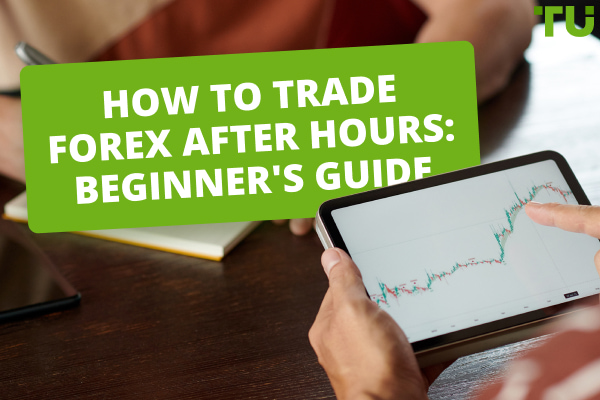Forex Trading Fees And Costs Explained
The main types of Forex fees include:
-
Spreads - gap between bid and ask
-
Commissions - paid on a per lot basis
-
Swap rates - charged for positions held overnight
-
Gapping - sudden and irregular jump in price
-
Financing costs - for availing leverage
-
Withdrawal fees - for transferring money to your account
Forex trading presents a gateway to financial opportunities, but it's essential for traders to navigate the intricate landscape of fees and costs to make informed decisions. In this article, the experts at TU will cover the most important Forex fees that traders might incur and emphasize the hidden costs as well, so you can stay aware and plan your trading strategy around them.
What are Forex trading costs?
In simple terms, Forex trading costs represent the money you incur to avail yourself of a brokerage's services to engage in trading and oversee your investments. These fees encompass various aspects, such as transaction fees, withdrawal charges, inactivity penalties, research-related expenses, and annual fees. To effectively manage your finances and trading endeavors, it's crucial to grasp the complete fee structure and the diverse policies that accompany it.
It's important to note that brokerage fee structures and rules can differ significantly from one broker to another. These fees can be broadly categorized into two primary types:
-
1
Trading fees: These fees come into play only when you execute a trade. They encompass a range of charges, including conversion fees, margin rates, financing rates, spreads, and commissions
-
2
Non-trading fees: These fees aren't directly linked to your trading actions and can include inactivity charges, withdrawal fees, deposit fees, and more
What are the main types of Forex fees?
1. Spreads
Consider the spread as the fee your broker levies for facilitating your trades. As you might already know, brokers provide two prices for each currency pair: the buying price (bid price) and the selling price (ask price). The spread is essentially the gap between these two prices and represents the cost imposed by the broker for their services. This is how brokers generate their revenue and sustain their operations.
For instance, let's say you want to initiate a long (buy) trade on the EUR/USD currency pair, and your price chart displays a rate of 1.3000. However, your broker quotes two prices: 1.3002 for buying and 1.3000 for selling. When you hit the buy button, your position will be entered at 1.3002, resulting in a 2-pip charge for the spread (the difference between 1.3002 and 1.3000).
Even when you decide to close a short (sell) trade, you'll still encounter the spread. Suppose the price chart shows 1.3000 for selling, then, even if the last traded price is 1.3002, the sell order will only be executed if you’re willing to accept the rate of 1.3000.
In essence, the spread signifies the disparity between the buying and selling prices of any asset or currency pair. This spread is a trading cost for you and a source of income for the broker. The bid price reflects the highest amount the broker will pay to purchase the instrument from you, while the ask price represents the lowest sum the broker will charge to sell the instrument to you.
To turn a profit or avoid losses in a trade, the price must move sufficiently to offset the spread cost.
Variable rate spreads
It's worth noting that the spread you encounter can fluctuate based on market volatility and the specific currency pair you're trading. Variable spreads like these are common in markets characterized by higher volatility.
For example, during periods of low market activity and minimal volatility, a broker may impose a +3 pip spread. However, if volatility spikes or liquidity diminishes, the broker may adjust the spread to account for the heightened risk associated with a faster-moving and thinner market.
Additionally, some brokers may charge a commission for executing and handling trades. In such cases, the spread adjustment might be minimal or non-existent since the broker primarily earns revenue through these commissions.
2. Commissions
While certain accounts offer spreads as low as 0.1 pips for the EUR/USD currency pair, they may come with a commission per lot traded. These accounts are typically known as ECN (Electronic Communication Network) accounts, operating without a dealing desk. Traders enjoy the raw spreads or something very close to them, while the broker levies a commission fee.
Commissions also apply to equity trades and various other assets such as ETFs, ETCs, and bonds. To understand which assets carry commission charges, traders should consult their broker's asset directory or find this information directly on their trading platform. Transparent brokers typically list comprehensive contract specifications on their website, while proprietary trading platforms provide all the necessary information within each trade ticket. Many brokers offer volume discounts for accounts that incur commission fees.
Commissions can be calculated in two primary ways:
Fixed fee
Under this model, the broker charges a fixed amount, regardless of the trade's size and volume. For example, a broker might charge a $2 commission per executed transaction, irrespective of its size.
Relative fee
This is the more common method of commission calculation. The amount a trader pays is determined by the trade's size. For instance, the broker may charge "$100 per $1 million in traded volume." In essence, the greater the trading volume, the higher the cash value of the commissions.
3. Swap rates
Swap rates, also known as rollover rates, pertain to positions held overnight. These rates result from disparities in interest rates between the base currency and the quoted currency. Brokers will specify how they calculate these rates, and there are two types – Swap extLong and Swap Short rates. Depending on whether you hold a long or short position, swap rates will either be credited to or debited from your account balance. It's important to note that not all brokers pass on positive swap rates to traders.
4. Market gapping
For traders who specialize in news-based trading, the concept of market gapping becomes a significant concern. Gapping signifies abrupt and substantial price jumps that occur without any recorded prices in between two levels. This phenomenon often arises due to unforeseen economic data releases, political shifts, or major global events. Gapping can manifest at any moment and is entirely beyond the control of individual traders. During periods of high market volatility, such as during the release of important economic reports, spreads can rapidly expand or contract by several pips. If your preferred trading strategy revolves around news events, it's crucial to factor in these potential costs and account for their impact.
5. Financing expenses
When initiating a leveraged trade, your broker imposes financing expenses. To illustrate, if your trading account holds $15,000, but your total position size reaches $150,000, you must borrow the remaining $135,000 from your broker and subsequently bear financing costs. These costs have the potential to influence your overall trading profitability and should be included in your trade planning.
6. Withdrawal fees
Upon successfully closing a profitable trade and electing to withdraw your earnings to your bank account, you may encounter a withdrawal fee, unless your broker offers a complimentary monthly withdrawal option.
What are the hidden Forex fees?
1. Storage fees
Some brokers impose storage fees on traders for maintaining certain assets in their accounts. These fees are an unnecessary addition and are incurred in addition to swap and financing fees. Essentially, they represent a cost for keeping positions within your portfolio. As an investor (not trader), it's advisable to avoid brokers who charge extremely high storage fees.
2. Custodial Fees
Equity, ETFs, Forex and bonds might come with custodial fees, typically calculated as a small annualized percentage. Some brokers might deduct these fees monthly, setting a minimum threshold. It's important to note that not all brokers offer equity or bond trading; instead, they utilize CFDs (Contracts for Difference), which allow you to participate in price movements without incurring custodial fees.
3. Overnight positions
For traders holding positions overnight, there's an additional cost to consider. This cost primarily applies to the Forex market and is known as the overnight rollover.
Every currency you buy or sell comes with its own overnight interest rate. The difference between the interest rates of the currencies you're trading determines the cost of holding the position overnight. An important point to note however, is that these rates aren't determined by your broker but are set at the Interbank level.
These trading costs are percentage-based and escalate as you increase your use of leverage. In other words, the more leverage you employ, the higher these costs become. For instance, if you buy the GBP/USD pair, the rollover cost will hinge on the difference between the UK and USA interest rates. If the UK boasts a 5% interest rate and the USA offers 4%, you'll receive a payment of 1% on your position because you're buying the currency from the nation with the higher interest rate. Conversely, if you were selling this currency, you would be charged 1%.
4. Data feeds
Beyond the direct transactional costs of trading, traders should factor in additional expenses when calculating their overall profitability. Data feeds are a crucial part of this equation as they provide traders with real-time market information, including news updates and price action analysis.
Traders rely on this data to make vital decisions such as when to enter or exit the market, how to manage open positions, and where to set stop-loss orders. The quality and nature of data feeds can vary among providers, as can the associated costs, which are typically a fixed monthly charge.
What are the main types of accounts that a Forex broker provides?
Forex brokers typically provide various types of trading accounts, with two of the most widely used options being standard trading accounts and raw spread accounts. The choice between these accounts hinges on several factors, including your trading volume and strategy.
1. Standard accounts
Standard accounts serve as the entry point for retail traders in the Forex market. These accounts are characterized by how brokers make their profit, primarily through spreads. Spreads can vary, starting from 1 pip and increasing from there. The distinctive feature of standard accounts is that they do not impose any commission charges on trades. Instead, brokers generate revenue through the spread itself.
2. Professional or "Raw" accounts (ECN Accounts)
Professional accounts, often referred to as "raw" accounts or ECN (Electronic Communication Network) accounts, provide traders with access to real market prices for all available instruments. In these accounts, Forex brokers refrain from adding any markups to the Forex prices. As a result, spreads are typically extremely low, sometimes even reaching zero. However, there's a trade-off – traders using professional accounts are required to pay a commission fee for each trade executed.
The commission structure can vary among brokers. Some charge fees for both opening and closing trades, while others assess fees for a complete round-trip, which includes both the opening and closing of a lot. The choice between standard and professional accounts depends on your specific trading style and objectives.
FAQs
What fees does Forex charge?
Forex trading is inherently exposed to fees known as spreads and, in some cases, commissions.
How is trade cost calculated in Forex?
Trade cost in Forex is typically calculated based on the spread and, if applicable, commission fees.
What is the formula for trading costs?
Trading costs are calculated by considering the difference between the buying (ask) price and the selling (bid) price, along with any commission fees.
How much is 1 pip in Forex?
The value of 1 pip in Forex varies depending on the currency pair and trade size, but it's generally a small fraction of the currency's value, often around $0.10 to $10 or more.
Team that worked on the article
Chinmay Soni is a financial analyst with more than 5 years of experience in working with stocks, Forex, derivatives, and other assets. As a founder of a boutique research firm and an active researcher, he covers various industries and fields, providing insights backed by statistical data. He is also an educator in the field of finance and technology.
As an author for Traders Union, he contributes his deep analytical insights on various topics, taking into account various aspects.
Dr. BJ Johnson is a PhD in English Language and an editor with over 15 years of experience. He earned his degree in English Language in the U.S and the UK. In 2020, Dr. Johnson joined the Traders Union team. Since then, he has created over 100 exclusive articles and edited over 300 articles of other authors.
The topics he covers include trading signals, cryptocurrencies, Forex brokers, stock brokers, expert advisors, binary options. He has also worked on the ratings of brokers and many other materials.
Dr. BJ Johnson’s motto: It always seems impossible until it’s done. You can do it.
Mirjan Hipolito is a journalist and news editor at Traders Union. She is an expert crypto writer with five years of experience in the financial markets. Her specialties are daily market news, price predictions, and Initial Coin Offerings (ICO). Mirjan is a cryptocurrency and stock trader. This deep understanding of the finance sector allows her to create informative and engaging content that helps readers easily navigate the complexities of the crypto world.









